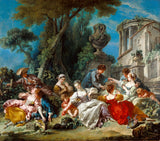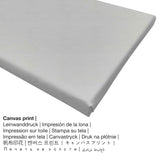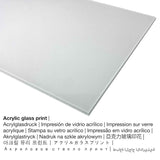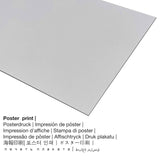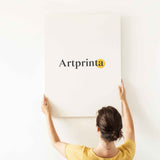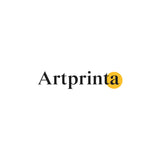François Boucher, 1748 - Ndị Nnụnụ Nnụnụ - mbipụta nka mara mma
Ụtụ gụnyere. Mbupu gbakọrọ na ndenye ọpụpụ.
Nye iwu ihe ị chọrọ
In the product dropdown selection you can pick your individual material and size. Pick your favorite size and material among the following options:
- Metal (aluminium debond mbipụta): An Aluminium Dibond print is a print material with a true depth effect. A direct Direct Print on Aluminum Dibond is the ideal introduction to the sophisticated world of fine art replicas manufactured with aluminum. The white & bright sections of the work of art shimmer with a silky gloss but without the glare. Colors are luminous, the fine details are crisp. This direct print on Aluminum Dibond is the most popular entry-level product and is a sophisticated way to display art, since it puts all of the viewer’s attention on the image.
- Mbipụta akwụkwọ mmado (ihe kwaaji): A poster print is a printed canvas paper with a granular texture on the surface, that resembles the original work of art. Please bear in mind, that depending on the size of the poster print we add a white margin of approximately 2-6cm round about the print motif, which facilitates the framing with your custom frame.
- Kwaaji: The canvas print, not to be mistaken with a real painting on a canvas, is a digital image printed directly on cotton canvas material. Your canvas print of this artpiece will allow you to transform your art print into a large size artwork. Hanging a canvas print: Canvas prints are relatively low in weight, which implies that it is easy to hang the Canvas print without the help of any wall-mounts. A canvas print is suited for all kinds of walls.
- Mbipụta iko acrylic (nke nwere ezigbo mkpuchi iko): An acrylic glass print, often labelled as a plexiglass print, will turn the original artwork into lovely décor and is a distinct alternative option to dibond and canvas fine art prints. The artwork is being printed with the help of modern UV print machines. The major benefit of an acrylic glass fine art copy is that contrasts and granular artwork details become more recognizeable due to the fine tonal gradation. The real glass coating protects your selected art replica against light and external influences for many more years.
Ozi dị mkpa: We try whatever we can to describe our products with as many details as possible and to showcase them visually. Nonetheless, the colors of the printing material and the printing may differ slightly from the presentation on your screen. Depending on the settings of your screen and the nature of the surface, colors might not be printed 100% realistically. Given that all are printed and processed manually, there may also be slight deviations in the exact position and the size of the motif.
What does the curator team of the The J. Paul Getty Museum say about this 18th century artwork created by François Boucher? (© Copyright - The J. Paul Getty Museum - Ụlọ ihe ngosi nka nke J. Paul Getty)
Responding to the contemporary rage for pastorals depicting amorous countryside games, François Boucher here exhibited young, fashionable couples in the act of catching birds. In the 1700s, small birds played an important symbolic role in courtship ritual: the gift of a caged bird from a man to a woman signified her capture of his heart. Posed in front of the ruins of a temple to Vesta, young aristocratic women dressed in exquisite finery play with small birds; some still hold them on strings while others daintily hold them on their fingers.
The Bird Catchers and its pendant, The Fountain of Love, were finished cartoons or models for a series of tapestries known as the Noble Pastorales. Eventually, the cartoons were cut up into sections and sold separately. The tapestries reveal how large the cartoons originally were and how much is missing from the cut-up sections.
Ntụgharị nka nke gị
N'elu 270 ihe nka afọ afọ aha ya The Bird Catchers was made by the painter François Boucher in the year 1748. Ihe gafere 270 afọ mbụ okike tụrụ nha: 294,6 × 337,8 cm (116 × 133 na) ewe me ya ka ọ were ihe-ọcha mmanụ na kwaaji. Ọrụ nka a gụnyere na nchịkọta nka nke Ụlọ ihe ngosi nka nke J. Paul Getty, nke dị na Los Angeles, California, Njikota Obodo Amerika. Nke a masterpiece, nke dị na ngalaba ọha is being provided with courtesy of The J. Paul Getty Museum.The creditline of the artwork is: . Moreover, alignment is in odida obodo usoro ma nwee oke nke 1.2: 1, which implies that the length is 20% longer than the width. François Boucher was a painter from France, whose style was mainly Rococo. The European artist lived for a total of 67 afọ, amuru na afo 1703 ma nwụọ na 1770 na Paris.
Tebụl a haziri ahazi nke ihe osise
| Aha nka: | "The Bird Catchers" |
| Nhazi: | sere |
| Nhazi nka: | nka ochie |
| Century: | 18th narị afọ |
| Ekepụtara: | 1748 |
| Ogologo afọ nka nka: | ihe karịrị afọ 270 |
| Ihe osise izizi: | mmanụ na kwaaji |
| Akụkụ izizi nka: | 294,6 × 337,8 cm (116 × 133 na) |
| Ụlọ ihe ngosi nka / ebe: | Ụlọ ihe ngosi nka nke J. Paul Getty |
| Ebe ngosi nka: | Los Angeles, California, Njikota Obodo Amerika |
| Ebe nrụọrụ weebụ ihe ngosi nka: | Ụlọ ihe ngosi nka nke J. Paul Getty |
| Ụdị ikike nka: | ngalaba ọha |
| Site n'aka: | Ụlọ ihe ngosi nka nke J. Paul Getty |
Nkọwapụta ngwaahịa
| Bipụta ngwaahịa: | ọmarịcha nka |
| Mmeputakwa: | dijitalụ mmeputakwa |
| Usoro mmepụta: | UV kpọmkwem obibi |
| Ihe ngosi: | emepụtara na Germany |
| Ụdị ngwaahịa: | mmepụta ihe na-achọ |
| Eji ngwaahịa a chọrọ: | ihe ndozi mgbidi, foto mgbidi |
| Nhazi onyonyo: | nhazi odida obodo |
| Oke akụkụ: | 1.2: 1 |
| Nsonaazụ: | ogologo bụ 20% ogologo karịa obosara |
| Nhọrọ dị: | Mbipụta kwaaji, mbipụta enyo acrylic (nwere ezigbo mkpuchi iko), mbipụta akwụkwọ mmado (akwụkwọ kwaaji), mbipụta ọla (aluminium dibbond) |
| Nhọrọ nha nke akwa akwa n'elu etiti ihe na-agbatị (mbipụta kwaaji): | 60x50cm - 24x20", 120x100cm - 47x39", 180x150cm - 71x59" |
| Mbipụta iko acrylic (nwere ezigbo mkpuchi iko) nhọrọ nha: | 60x50cm - 24x20", 120x100cm - 47x39", 180x150cm - 71x59" |
| Nhọrọ nke mbipụta akwụkwọ mmado (akwụkwọ kwaaji): | 60x50cm - 24x20", 120x100cm - 47x39" |
| Mbipụta nke aluminom: | 60x50cm - 24x20", 120x100cm - 47x39" |
| Igwe onyonyo: | na-enweghị etiti |
Tebụl nkọwa omenkà
| Ihe nkiri: | François Boucher |
| okike nke onye nka: | nwoke |
| Nationality: | French |
| Ọrụ: | onye na-ese ihe |
| Obodo obibi: | France |
| Nhazi nke onye nka: | nna ukwu ochie |
| Ụdị nka: | Rococo |
| Akwụsị: | 67 afọ |
| Afọ ọmụmụ: | 1703 |
| Afọ nwụrụ: | 1770 |
| Obodo ọnwụ: | Paris |
© echekwabara ikike nwebiisinka, Artprinta.com

